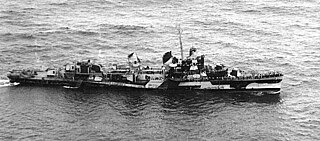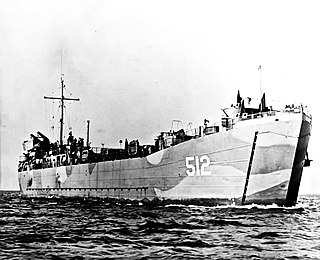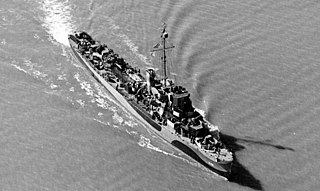
USS Birmingham (CL-62), a United States Cleveland-class light cruiser named for the city of Birmingham, Alabama, the "Pittsburgh of the South", was laid down at the Newport News Shipbuilding and Dry Dock Company of Newport News, Virginia, on 17 February 1941 and launched on 20 March 1942 by Mrs. Cooper Green, wife of the president of the Birmingham City Commission. She was commissioned on 29 January 1943, Captain John Wilkes in command. Birmingham earned eight battle stars, receiving heavy damage on at least three occasions.

USS Bache (DD/DDE-470), a Fletcher-class destroyer, was the second ship of the United States Navy of that name. The destroyer was named for Commander George M. Bache.

USS Evans (DD-552), a Fletcher-class destroyer, was the second ship of the United States Navy to be named for Rear Admiral Robley D. Evans (1846–1912).

USS Guest (DD-472), a Fletcher-class destroyer, was a ship of the United States Navy named for Commodore John Guest (1822–1879).

USS Hudson (DD-475), a Fletcher-class destroyer, was the second ship of the United States Navy to be named for Captain William L. Hudson (1794–1862).

USS Borie (DD-704), an Allen M. Sumner-class destroyer, was the second ship of the United States Navy to be named for Adolph E. Borie, Secretary of the Navy under President Ulysses S. Grant.

USS Samuel N. Moore (DD-747), an Allen M. Sumner-class destroyer, is the only ship of the United States Navy to be named for Samuel N. Moore.

USS Miller (FF-1091), originally (DE-1091) was a Knox-class destroyer escort in the United States Navy. She was named for Cook Third Class Doris "Dorie" Miller, who was awarded the Navy Cross for his actions at the attack on Pearl Harbor.

The Phutthayotfa Chulalok-class frigates are two of forty-six Knox-class frigates originally laid down for the United States Navy as ocean escorts, but were all redesignated as frigates on 30 June 1975, in the USN 1975 ship reclassification and their hull designation changed from DE to FF. The Thai Navy acquired them between 1994 and 1996.

USS Blessman (DE-69/APD-48), a Buckley-class destroyer escort of the United States Navy, was named in honor of Lieutenant Edward Martin Blessman (1907–1942), who was killed in action in the Pacific on 4 February 1942.

USS Burnett County (LST-512) was an LST-491-class tank landing ship built for the United States Navy during World War II. Named for Burnett County, Wisconsin, she was the only U.S. Naval vessel to bear the name.

USS Gurke (DD-783) was a Gearing-class destroyer of the United States Navy, in service from 1945 to 1976. She was transferred to Greece in 1977 and served as Tombazis until 1997.

USS Frament (DE-677/APD-77) was a Buckley-class destroyer escort in the United States Navy.

USS Swearer (DE-186) was a Cannon-class destroyer escort in the United States Navy during World War II. She was later transferred to the French Navy as Bambara.

USS Oberrender (DE-344) was a John C. Butler–class destroyer escort built for the United States Navy during World War II. She was named for Lieutenant Commander Thomas Olin Oberrender Jr., the engineering officer of the light cruiser USS Juneau, who was killed when that ship was torpedoed and sunk during the Naval Battle of Guadalcanal in 1942.

USS Clarence L. Evans (DE-113) was a Cannon-class destroyer escort built for the United States Navy during World War II. She served in the Atlantic Ocean and provided escort service against submarine and air attack for Navy vessels and convoys. She was launched on 22 March 1944 by Dravo Corporation, Wilmington, Delaware, sponsored by Mrs. E. E. Evans; commissioned on 25 June 1944, Lieutenant Commander W. C. Hughes, USNR, in command; and reported to the Atlantic Fleet.

USS Riddle (DE-185) was a Cannon-class destroyer escort in service with the United States Navy from 1943 to 1946. In 1950, she was transferred to France where she served as Kabyle (F718) until being decommissioned and scrapped in 1959.

USS Paul G. Baker (DE-642) was a Buckley-class destroyer escort in service with the United States Navy from 1944 to 1946. She was scrapped in 1970.

USS Pavlic (APD-70) was built by Dravo Corporation at Pittsburgh, Pennsylvania as a Buckley-class destroyer escort. Pavlic was launched 18 December 1943 and towed to Texas for refitting as a United States Navy high-speed transport. Pavlic was in commission from 1944 to 1946, serving in the Okinawa campaign as a radar picket ship. Pavlic was decommissioned 15 November 1946. After more than 20 years of inactivity in reserve, she was stricken from the Navy List on 1 April 1967. On 1 July 1968, she was sold for scrapping to North American Smelting Company.

USS Guam (CB-2) was an Alaska-class large cruiser which served with the United States Navy during the end of World War II. She was the second and last ship of her class to be completed. The ship was the second vessel of the US Navy to be named after the island of Guam, an American territory in the Pacific. Due to her commissioning late in the war, Guam saw relatively limited service during the war. She participated in operations off Okinawa in March–July 1945, including providing anti-aircraft defense for the carrier task force and conducting limited shore bombardment operations. She participated in sweeps for Japanese shipping in the East China and Yellow Seas in July–August 1945. After the end of the war, she assisted in the occupation of Korea and transported a contingent of US Army troops back to the United States. She was decommissioned in February 1947 and placed in reserve, where she remained until she was stricken in 1960 and sold for scrapping the following year.





















